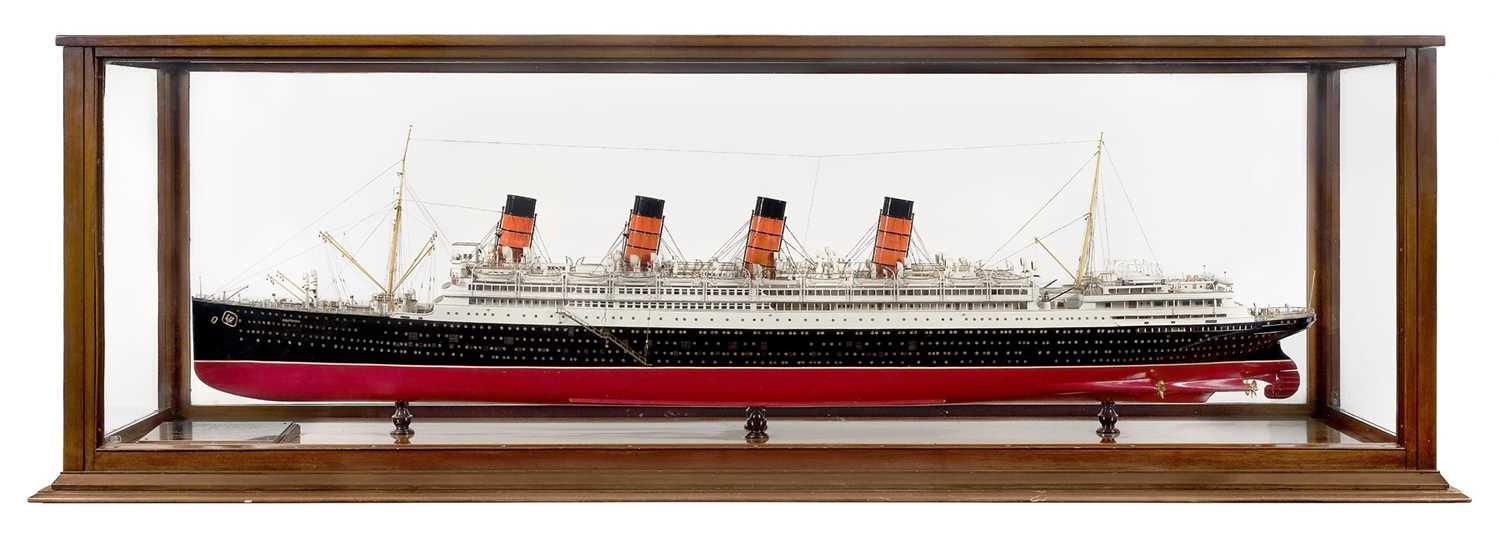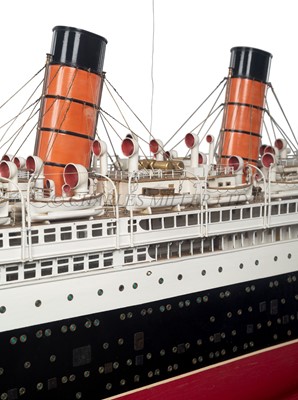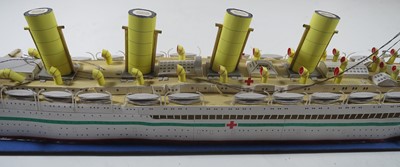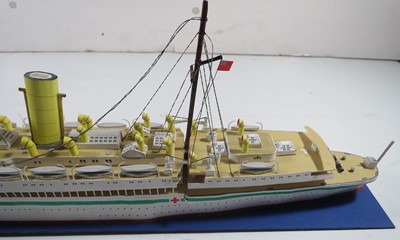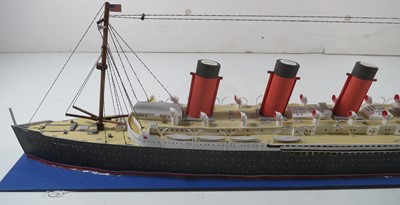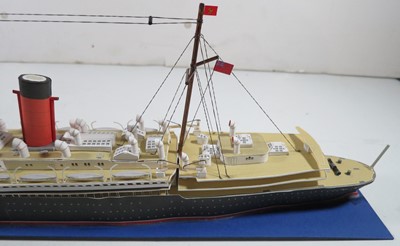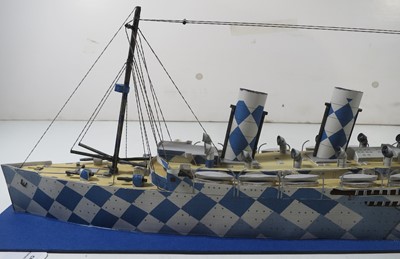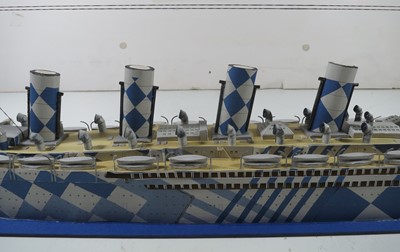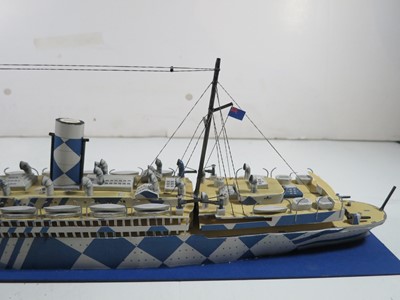23rd Apr, 2024 10:00
Maritime and Scientific Models, Instruments & Art (ZEEBRUGGE)
73
[M] A FINE BUILDER'S MODEL FOR THE R.M.S. 'AQUITANIA', CONSTRUCTED BY JOHN BROWN & CO., CLYDEBANK FOR CUNARD, 1914
A FINE BUILDER'S MODEL FOR THE R.M.S. AQUITANIA, CONSTRUCTED BY JOHN BROWN & CO., CLYDEBANK FOR CUNARD, 1914
with 88in. laminated and carved hull replete with detailed painted and gilt fittings as appropriate and contained in original glazed case with presentation plate from Cunard, finished in Cunard service livery, overall measurements -- 33¼ x 103 x 23½in. (84.5 x 261.5 x 59.5cm.); together with associated 36in. high table stand; and three card and paper models of Aquitania as a troop ship, hospital ship, and cruise liner
(5)
The Honourable Company of Master Mariners; Presented by Cunard Steamship Company in 1952.
Arguably the most successful of the great pre-1914 North Atlantic liners, as well as being regarded by many as the most handsome of all the legendary 'four-stackers', Aquitania was undeniably the longest-lived of that glamorous breed of ocean greyhounds. Conceived as a consort to Lusitania and Mauretania, Cunard ordered her from John Brown's Clydebank yards in December 1910 where she was launched on 21st April 1913. Named for the ancient Roman province in southwest France, her design was broadly similar to her two sisters, although she was significantly larger in every respect. Registered upon completion at 45,647 tons gross, she measured 901 feet in length with a 97-foot beam, but was never intended to outstrip Lusitania and Mauretania in terms of speed. Powered by quadruple screws driven from Parsons-Brown 62,000shp. steam turbines, she was designed to cruise at 23 knots, in fact achieving an effortless 24 knots on her trials. Sumptuously fitted out and with accommodation for 618 First, 614 Second, and 1,998 Third class passengers, she carried a crew of 972 and entered service amidst high expectations thanks to the reputations of her two older sisters.
Clearing Liverpool on 30th May 1914 for her maiden voyage to New York, she was only to complete three round trips before being requisitioned by the British Government in August 1914 upon the outbreak of the Great War. Designed and built under Admiralty supervision, it had always been expected that, in times of war, Aquitania would assume the guise of an armed merchant cruiser, but in the event, as with others like her, she proved far too large for this role. Slightly damaged in a collision within a month of beginning her wartime career, she returned to Liverpool and was laid up until the spring of 1915 when she began work transporting troops for the offensive at Gallipoli. Soon converted into a hospital ship for the same campaign, she resumed trooping in 1916, was laid up for most of 1917 but was back in service in 1918 carrying troops from the U.S.A. to France. Between June and November 1919, she ran a brief 'austerity service' between Southampton and New York but was sent to Armstrong, Whitworth's yards at Newcastle that December for a major post-war refit including conversion to oil-firing.
Returning to regular commercial sailings in July 1920, her splendid decor attracted passengers immediately and she soon settled down to become one of the most popular liners on the North Atlantic over the next two decades. Apart from the occasional Mediterranean cruise in the early years of the Depression, Aquitania remained a stalwart on the Atlantic ferry and, after 1936, became the new Queen Mary's running mate whilst Queen Elizabeth was under construction. With the latter destined for completion in 1940, it was intended that Aquitania would be scrapped when the second 'Queen' entered service, but this plan was abandoned when the Second World War began in September 1939. Converted into a troop transport for the second time in her life, she spent the next eight years carrying 300,000 servicemen all over the world, the sole survivor of the Edwardian giants and the only one to serve in both World Wars. 1948 found her ferrying war brides to Canada prior to being returned to Cunard for yet another post-war 'austerity service'. Hastily refitted and repainted in traditional livery, although never restored to her former magnificence, she maintained a one-class Southampton to Halifax service for a further year and a half before being finally withdrawn in December 1949. After three million miles and thirty-five years at sea, her scrapping at Faslane in the spring of 1950 brought the era of the majestic 'four-stackers' to an end and thereby closed a notable chapter in the history of North Atlantic navigation.
Sold for £54,560
Estimated at £30,000 - £40,000
(inc. buyer's premium of 24%)
A FINE BUILDER'S MODEL FOR THE R.M.S. AQUITANIA, CONSTRUCTED BY JOHN BROWN & CO., CLYDEBANK FOR CUNARD, 1914
with 88in. laminated and carved hull replete with detailed painted and gilt fittings as appropriate and contained in original glazed case with presentation plate from Cunard, finished in Cunard service livery, overall measurements -- 33¼ x 103 x 23½in. (84.5 x 261.5 x 59.5cm.); together with associated 36in. high table stand; and three card and paper models of Aquitania as a troop ship, hospital ship, and cruise liner
(5)
The Honourable Company of Master Mariners; Presented by Cunard Steamship Company in 1952.
Arguably the most successful of the great pre-1914 North Atlantic liners, as well as being regarded by many as the most handsome of all the legendary 'four-stackers', Aquitania was undeniably the longest-lived of that glamorous breed of ocean greyhounds. Conceived as a consort to Lusitania and Mauretania, Cunard ordered her from John Brown's Clydebank yards in December 1910 where she was launched on 21st April 1913. Named for the ancient Roman province in southwest France, her design was broadly similar to her two sisters, although she was significantly larger in every respect. Registered upon completion at 45,647 tons gross, she measured 901 feet in length with a 97-foot beam, but was never intended to outstrip Lusitania and Mauretania in terms of speed. Powered by quadruple screws driven from Parsons-Brown 62,000shp. steam turbines, she was designed to cruise at 23 knots, in fact achieving an effortless 24 knots on her trials. Sumptuously fitted out and with accommodation for 618 First, 614 Second, and 1,998 Third class passengers, she carried a crew of 972 and entered service amidst high expectations thanks to the reputations of her two older sisters.
Clearing Liverpool on 30th May 1914 for her maiden voyage to New York, she was only to complete three round trips before being requisitioned by the British Government in August 1914 upon the outbreak of the Great War. Designed and built under Admiralty supervision, it had always been expected that, in times of war, Aquitania would assume the guise of an armed merchant cruiser, but in the event, as with others like her, she proved far too large for this role. Slightly damaged in a collision within a month of beginning her wartime career, she returned to Liverpool and was laid up until the spring of 1915 when she began work transporting troops for the offensive at Gallipoli. Soon converted into a hospital ship for the same campaign, she resumed trooping in 1916, was laid up for most of 1917 but was back in service in 1918 carrying troops from the U.S.A. to France. Between June and November 1919, she ran a brief 'austerity service' between Southampton and New York but was sent to Armstrong, Whitworth's yards at Newcastle that December for a major post-war refit including conversion to oil-firing.
Returning to regular commercial sailings in July 1920, her splendid decor attracted passengers immediately and she soon settled down to become one of the most popular liners on the North Atlantic over the next two decades. Apart from the occasional Mediterranean cruise in the early years of the Depression, Aquitania remained a stalwart on the Atlantic ferry and, after 1936, became the new Queen Mary's running mate whilst Queen Elizabeth was under construction. With the latter destined for completion in 1940, it was intended that Aquitania would be scrapped when the second 'Queen' entered service, but this plan was abandoned when the Second World War began in September 1939. Converted into a troop transport for the second time in her life, she spent the next eight years carrying 300,000 servicemen all over the world, the sole survivor of the Edwardian giants and the only one to serve in both World Wars. 1948 found her ferrying war brides to Canada prior to being returned to Cunard for yet another post-war 'austerity service'. Hastily refitted and repainted in traditional livery, although never restored to her former magnificence, she maintained a one-class Southampton to Halifax service for a further year and a half before being finally withdrawn in December 1949. After three million miles and thirty-five years at sea, her scrapping at Faslane in the spring of 1950 brought the era of the majestic 'four-stackers' to an end and thereby closed a notable chapter in the history of North Atlantic navigation.
Auction: Maritime and Scientific Models, Instruments & Art (ZEEBRUGGE), 23rd Apr, 2024
61
Page turning catalogue here
Downloadable bid form here
Saleroom notice here
Order of Sale:
Mercantile Sail 1-47
Mercantile Steam 50-113
Naval Sail 115-181
Naval Steam 186-265
Navigational & Scientific Instruments 269-301
You will not be able to bid in person for this sale, however, there are a number of ways you can still participate:
- Absentee bid – you can place a bid through your account on this website or download a bid form here
- Online via one of the following platforms:
easyliveAuction: 3% surcharge or a flat-rate fee of £3
The Saleroom: 5% surcharge
We regret we are unable to offer telephone bidding for this sale
Shippers
Part & Parcel / shipping@partandparceluk.com / Tel: +44 (0)1252 545611
Alban Shipping / info@albanshipping.co.uk / Tel: +44 (0) 1582 493099
Viewing
From the 8th April by appointment only.
Please call or email to book a slot: Tel: (0)20 7806 5530 or enquiries@charlesmillerltd.com
Viewing at:
300 Munster Road
Fulham
London
SW6 6BH
